

Pendulum Clock Blog: Pendulum Clock. Pendulum clocks are mechanical marvels.
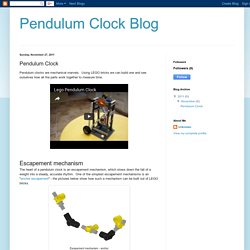
Using LEGO bricks we can build one and see ourselves how all the parts work together to measure time. Escapement mechanism The heart of a pendulum clock is an escapement mechanism, which slows down the fall of a weight into a steady, accurate rhythm. One of the simplest escapement mechanisms is an "anchor escapement" - the pictures below show how such a mechanism can be built out of LEGO bricks. Clock mechanism We need to transmit the gravitational force pulling the weight into a rotational movement of the escape wheel. We will need to use some gears to ensure that for each rotation of the escape wheel, the weight falls down just a little bit. Tuning the clock A pendulum equation shown below tells us that we can make the clock go faster by shortening the length of the pendulum or we can make it go slower, by lengthening the length of the pendulum.
Lego Pendulum Clock. Project Blog. LEGO Clock When I was at my parents for Christmas, we were visiting one of their neighbors who owned an old style mechanical clock.
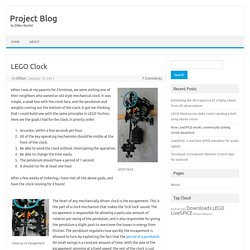
It was simple, a small box with the clock face, and the pendulum and weights coming out the bottom of the clock. It got me thinking that I could build one with the same principles in LEGO Technic. Here are the goals I had for the clock, in priority order: Accurate, within a few seconds per hour.All of the key operating mechanisms should be visible at the front of the clock.Be able to wind the clock without interrupting the operation.Be able to change the time easily.The pendulum should have a period of 1 second.It should run for at least one hour.
After a few weeks of tinkering, I have met all the above goals, and have the clock running for 4 hours! Close up of escapement The heart of any mechanically driven clock is the escapement. Adjustable pendulum bob and drive weight. Pendulum Clock. Clock. I made a clock out of LEGO, which works nicely.
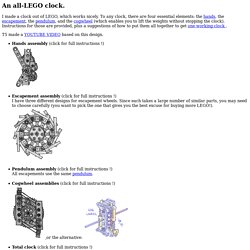
To any clock, there are four essential elements: the hands, the escapement, the pendulum, and the cogwheel (which enables you to lift the weights without stopping the clock). Instructions for those are provided, plus a suggestions of how to put them all together to get one working clock . T5 made a YOUTUBE VIDEO based on this design. Hands assembly (click for full instructions !) Escapement assembly (click for full instructions !) Then, when you have all the parts, you may want to build the actual clock. Email: leo@science.uva.nl. 9686 click clock c8d4b485ce4cca6f7d1518c76ae99592. Lego working clock. LEGO gear reduction for small clock face. Dipity Online Timeline. Share Photos, Videos, Text, Music and Documents Easily.
TEMPO infanzia MCossar ICCervignano. Unità didattica: La ruota delle stagioni. LA RUOTA DELLE STAGIONI Il tempo della natura e del lavoro L’orologio delle stagioni guida i partecipanti in un viaggio attraverso il calendario, alla scoperta dei lavori dei contadini.
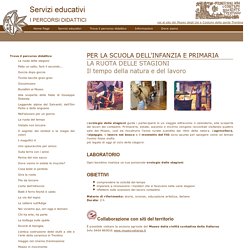
Primavera, estate, autunno e inverno vengono raccontati visitando quattro sale del Museo, così da ricostruire l’anno rurale scandito dai ritmi della natura. L’agricoltura, l’alpeggio, il lavoro nel bosco e il momento del filò sono spunto per spiegare come un tempo l’uomo fosse molto più legato di oggi al ciclo delle stagioni. Ogni bambino realizza un suo personale orologio delle stagioni. comprendere la ciclicità del tempoimparare a riconoscere i mestieri che si facevano nelle varie stagioniriflettere sulle scansioni del lavoro contadino. Make Your Own LEGO Skeleton Clock. An amazing lego clock mechanism! LEGO Mini Clock. L'orologio medievale. Beniamino e l'orologio medievale. Questo articolo accompagna il video su “l’orologio medievale” realizzato con materiali di recupero o di uso quotidiano: stecchini, stuzzicadenti, cartone, stecchini dei ghiaccioli, cannucce… È uno dei miei esperimenti preferiti, anche perché l’ho inventato io.
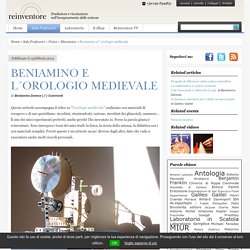
Forse la parola giusta è reinventato. Esso incorpora i temi dei miei studi: la fisica, la storia della scienza, la didattica con i con materiali semplici. Perciò questo è un articolo un po’ diverso dagli altri, dato che vado a raccontare anche molti ricordi personali. La prima volta che sentii parlare dell’orologio medievale fu sulle pagine di un libro di Stanley L. Jaki, “il Salvatore della Scienza”. Si trovava l’orologio meccanico, un elemento costante nelle chiese gotiche dal tardo tredicesimo secolo. Fu la passione per la storia della scienza a farmi sbilanciare verso l’insegnamento. Nel frattempo, leggevo moltissimo di storia della scienza, mi compravo molti libri usati su internet.
Cominciamo con questo, mi dissi. B.